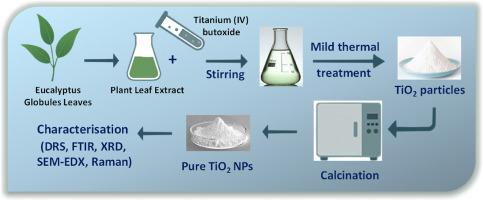利用蓝桉叶提取物绿色合成和表征二氧化钛纳米颗粒:温和热处理的影响
IF 7.9
3区 材料科学
Q1 GREEN & SUSTAINABLE SCIENCE & TECHNOLOGY
引用次数: 0
摘要
目前的研究工作正将相当多的注意力转向纳米材料的绿色合成,例如二氧化钛纳米颗粒(NPs),它以其广泛的技术应用而闻名。本研究首次报道了用桉叶提取物(一种温和的、可再生的、无毒的试剂)与丁氧化钛作为前体,在温和的热处理中合成TiO2 NPs。结果包括四种不同的生物合成材料样品,每种样品都通过应用不同的技术获得,包括NPs的单热处理和双热处理。最初通过傅里叶变换红外(FT-IR)和紫外可见光谱进行表征,植物提取物具有还原和稳定的双重作用,导致NPs具有显著的稳定性。植物化学成分,包括酚类和类黄酮酸,被认为可以减少Ti4+离子,帮助产生相关的NPs。通过漫反射紫外-可见光谱(DRS)、红外光谱(FT-IR)、拉曼光谱(Raman)、x射线粉末衍射(XRD)和扫描电子显微镜(SEM-EDX)对合成的TiO2样品进行了表征。这些研究结果强调了所有NP样品的纯净,均匀的结构和排列,表现出球形形态和锐钛矿形式的优势。计算了NPs的特征参数,包括粒径、带隙能、结晶度和晶格常数,并与工业TiO2进行了比较。与信号热处理样品和未处理样品相比,双热处理样品显示出与商业TiO2更接近的相似性。这表明,所提出的温和热处理可以作为一种有效且环保的制备TiO2 NPs的替代方法,确保良好的物理化学特性,以实现广泛的先进和可持续应用。本文章由计算机程序翻译,如有差异,请以英文原文为准。

Green synthesis and characterization of titanium dioxide nanoparticles using Eucalyptus globulus leaf extract: Impacts of the mild thermal treatment
Current research efforts are directing considerable attention towards the green synthesis of nanomaterials, such as titanium dioxide nanoparticles (NPs) known for their versatile technological applications. The present work is the first to report on the synthesis of TiO2 NPs using eucalyptus globulus leaf extract - a gentle, renewable, and non-toxic agent - in conjunction with titanium butoxide as a precursor in a mild thermal treatment. The results comprise four distinct biosynthesised material samples, each obtained by applying different techniques, including single and double-thermal treatments of NPs. Initially characterized by Fourier-transform infrared (FT-IR) and UV–visible spectroscopy, the plant extract plays a dual role in both reduction and stabilisation, leading to a remarkable NPs stability. The phytochemicals components, including phenolic and flavonoid acids, are believed to reduce the Ti4+ ions, aiding in the creation of related NPs. The successfully synthesised TiO2 samples were characterised with diffuse reflectance UV–visible spectroscopy (DRS), FT-IR, Raman, X-ray powder diffraction (XRD), and scanning electron microscopy with energy dispersive X-ray spectroscopy (SEM-EDX). The findings from these investigations highlighted the pure, uniform structure, and arrangement of all NP samples, exhibiting a spherical morphology and a predominance of the anatase form. The characteristic parameters of the NPs including particle size, band gap energy, crystallinity, and lattice constants, were calculated and compared to those of commercial TiO2. The double thermally treated sample exhibits a closer resemblance to commercial TiO2 compared to both the singal thermally treated sample and the untreated counterpart. This suggests that the proposed mild thermal treatment can serve as an alternative approach for the effective and environmentally friendly preparation of TiO2 NPs, ensuring good physico-chemical characteristics for a broad spectrum of advanced and sustainable applications.
求助全文
通过发布文献求助,成功后即可免费获取论文全文。
去求助
来源期刊

Materials Today Sustainability
Multiple-
CiteScore
5.80
自引率
6.40%
发文量
174
审稿时长
32 days
期刊介绍:
Materials Today Sustainability is a multi-disciplinary journal covering all aspects of sustainability through materials science.
With a rapidly increasing population with growing demands, materials science has emerged as a critical discipline toward protecting of the environment and ensuring the long term survival of future generations.
 求助内容:
求助内容: 应助结果提醒方式:
应助结果提醒方式:


